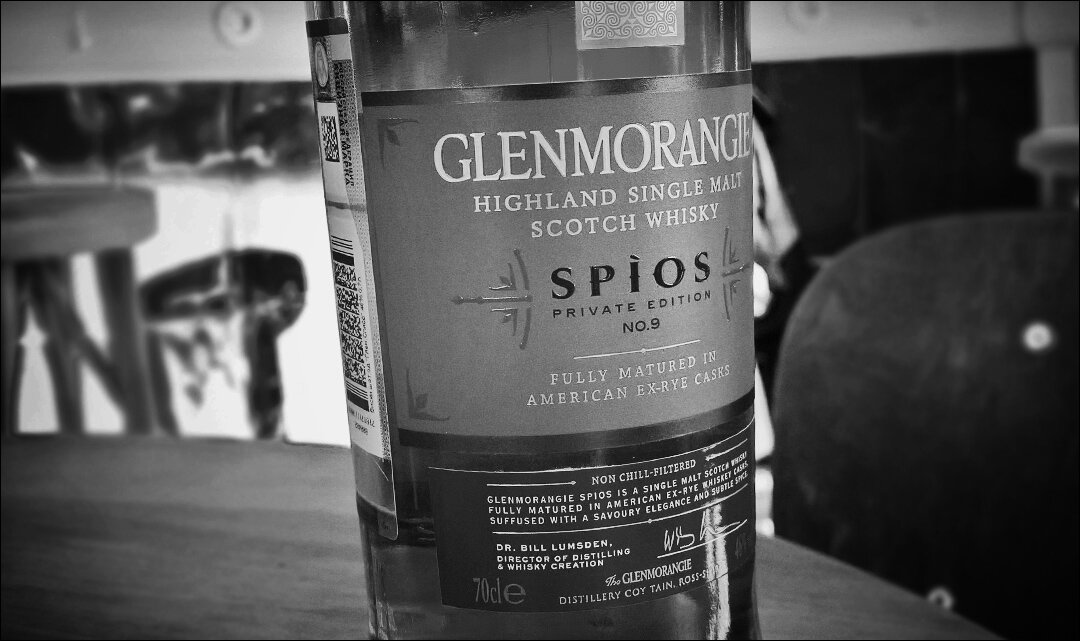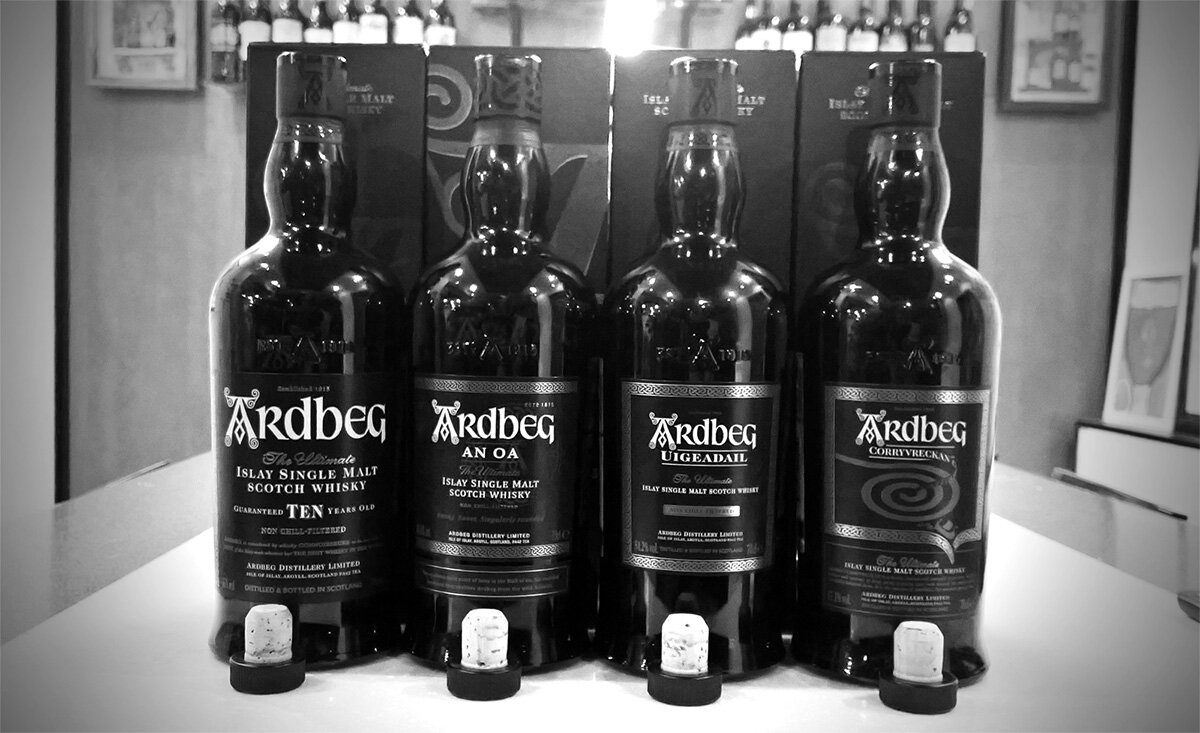Everybody knows that it is possible to distinguish a real malt-maniac from a person who came to a tasting session accidentally by several questions, which such a malt-maniac asks the session host. One of these questions, of course, is haughtily asked: «and how much ppm are in this whisky?». Undoubtedly, the professionalism of the host is determined by a knowledge of the innermost information about the amount of phenolic ppm in the whisky he or she is presenting. Information about this figure makes connoisseurs whether to nod with their heads, crouching, or to smirk, slightly shaking their heads.
If to speak more seriously, at one of the master-classes at Moscow Whisky Live 2018, the host suggested that we can not understand anything by investigating these phenolic ppm figures. The argument was that phenols level, measured at malt, “reaches” a new make in a completely different volume after the process of distillation on various equipment of different distilleries. That is why the initial value of phenols volume in the malt is not informative and does not matter. In addition, there are a lot of phenolic compounds in general, some of them come from maturation (wood), that is why it is also useless to measure ppm level on a matured whisky.
I could also add several more points to these arguments. Peatiness also depends on the timing the tails are cut, and that increases variability even if to work on an identical malt on the same equipment. As well peatiness level decreases during spirit maturation in wood containers, and such a maturation is also held under different conditions in different casks. So, shall we forget about phenolic ppm forever and all whisky-geeks are disgraced? It is not so straight and simple, let’s try to sort it out.
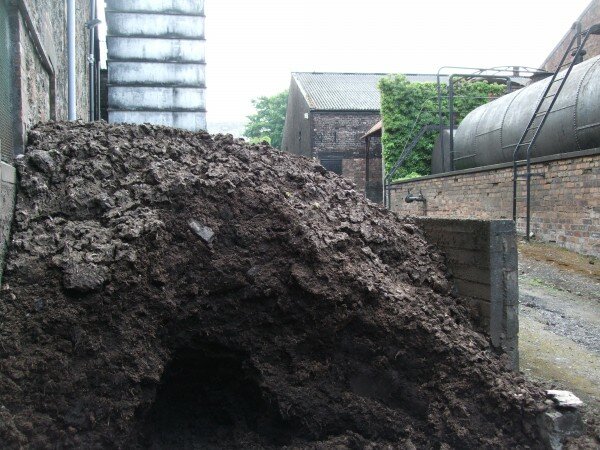
What are phenols?
Phenols are aromatic compounds that contain in their molecule a hydrocarbon group (6 carbon atoms in a ring linked with hydrogen atoms), the basis of many organic compounds, to which one or more hydroxyl groups (OH) are bonded. Polyphenol compounds contain several hydrocarbon (aromatic) rings with one or several hydroxyl groups bonded to them.
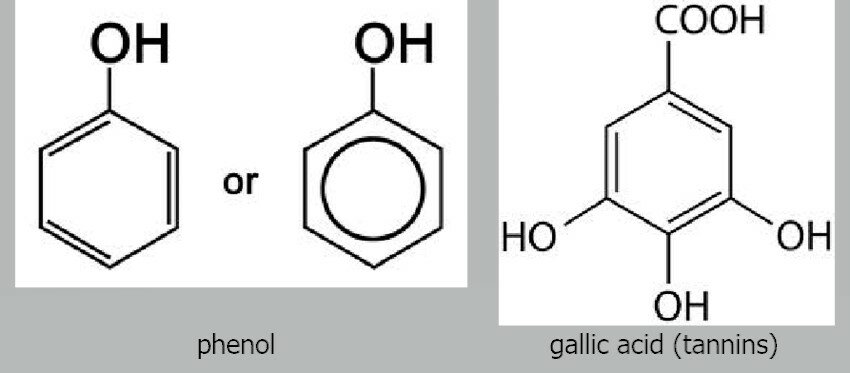
Phenol compounds are present in plants everywhere, give them colour and aroma, play an important role in such processes as photosynthesis, resistance of plants to infectious diseases, growth and reproduction, etc.
Sounds too scientific? Now you may forget everything you read above and remember only that in barley, in peat, in casks’ wood – everywhere there are a lot of different aromatic hydrocarbons. Tannins are also phenolic compounds, for example. Peat is formed from plants, as you know:
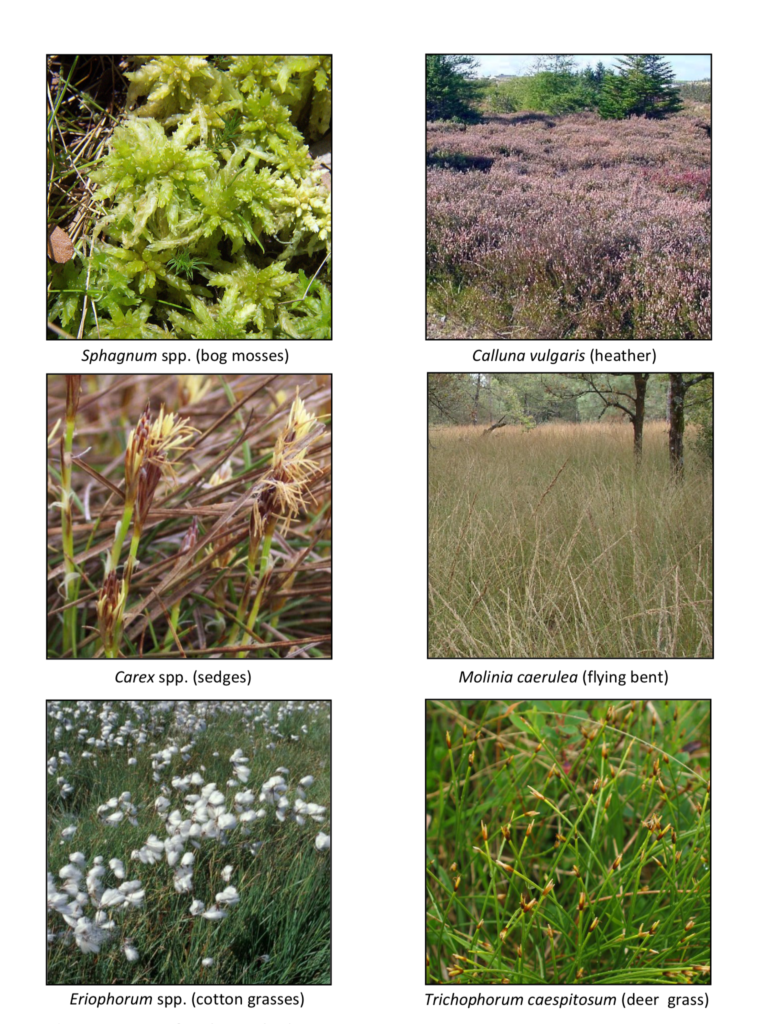
So, why doesn’t peat have a specific smokey smell while whisky has? In fact, peat (especially wet) smells as peat (somebody could distinguish this smell like the smell of earth, but if you live in areas with peat, you know that it is a bit different). Before peat is heated (burned), peat has no smoky aromas and its samples look pretty alike. The valley peat from the centre of Scotland could look similar both by an appearance and an analysis to valley peat of Islay, and basin peat from Islay – to any other basin peat. Here is a spectrogram of peat from six different locations in Scotland, which looks very similar (three fields on Islay, two in the central part of Scotland, one on Orkney):

Where are smells of smoke and medicine which we are looking for? And why do peaty aromas of whisky differ?
We should burn the peat for that. As a result of pyrolysis (heating with limited access of oxygen), hydrogen atoms in hydrocarbon ring are substituted, if to simplify a little bit, by other groups of atoms. As a result, besides phenol itself (carbonic acid), more complex compounds are formed. We are particularly interested in cresols, methylphenols, ethylphenols, guaiacoles. Namely these phenolic compounds «stick» to malt during the drying process and then get into whisky, giving it smell of smoke, medicinal/tar aromas and ashy tones. The difference in aroma depends both on peat composition and on technological features of the malt drying process.
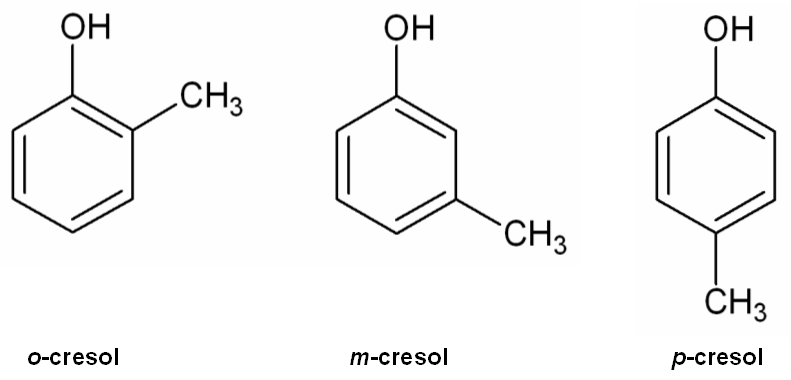
The proportion of phenols that get into the wort from barley husk is insignificant, so, the overwhelming part of phenols comes from peat. Therefore the term «peatiness» is fully correct.
Sometimes you may come across information that peatiness of whisky could also arise from natural water which is used in the production process. This is not true – even in case there are some organic substances in the water, these substances do not have relation to the smoky character of the whisky. Here is a water analysis on the components we are interested in for some distilleries:

As you see, there are only insignificant, far below the detection threshold level (33 μg/l), doses of 4-ethylguaiacol. By the way, if to assume that phenolic compounds in whisky have any relation to water composition, we should also agree that any tea made with untreated water from any bog must have smokey and medicinal aromas — check it yourself and you will see that this is not true — and here we speak about more complicated distillation process, where only volatiles find their way to the final product.
The same could be said about heavily charred casks – analysis of matured spirit made from unpeated malt showed the presence of phenol compounds in it, but no smokiness was observed. There are such derivatives of phenols as 4-ethylphenol (threshold level of determination of 425 μg/l) and 4-vinylphenol (605 μg/l) in the wood, which may give smokey aromas, but these compounds are not transferred in any significant quantities into the water/ethanol mixture while aging.
So, this is exactly drying of green malt on peat within a certain interval, when the moisture of sprouted grains is within 35-15% (according to other data – not less than 25%), what is fully responsible for a whisky peaty flavours. This process «anchors» the necessary types of phenol compounds in the malt.
How is this peatiness screened and measured?
The existence of phenolic compounds can be determined by spectrograph or chromatograph (and also by electrophoresis method). A spectrogram allows to determine the total number of phenolic compounds in a substance only, chromatography works better, it is possible to see what specific phenolic compounds are present. Given that we need to screen aromatic derivatives of phenolic compounds which give a smokey character to whisky, it is easier to measure peatiness on malt, as it contains mostly the phenols of the required spectrum (remember that there are also some tannins in the barley husk). If to measure phenolic compounds content on the matured whisky, you will see also “non-smokey” phenolic compounds, which were washed out from the wood.
In general, peatiness could be easily measured on a non-matured newmake, but, basically, nobody needs that – whisky producers obtain their malt in accordance to the required specification in terms of phenolic compounds content from malting companies and just continue to broadcast these figures to curious consumers.
Here are spectrograms of distillates made in 1975, analysing peated and unpeated malt:
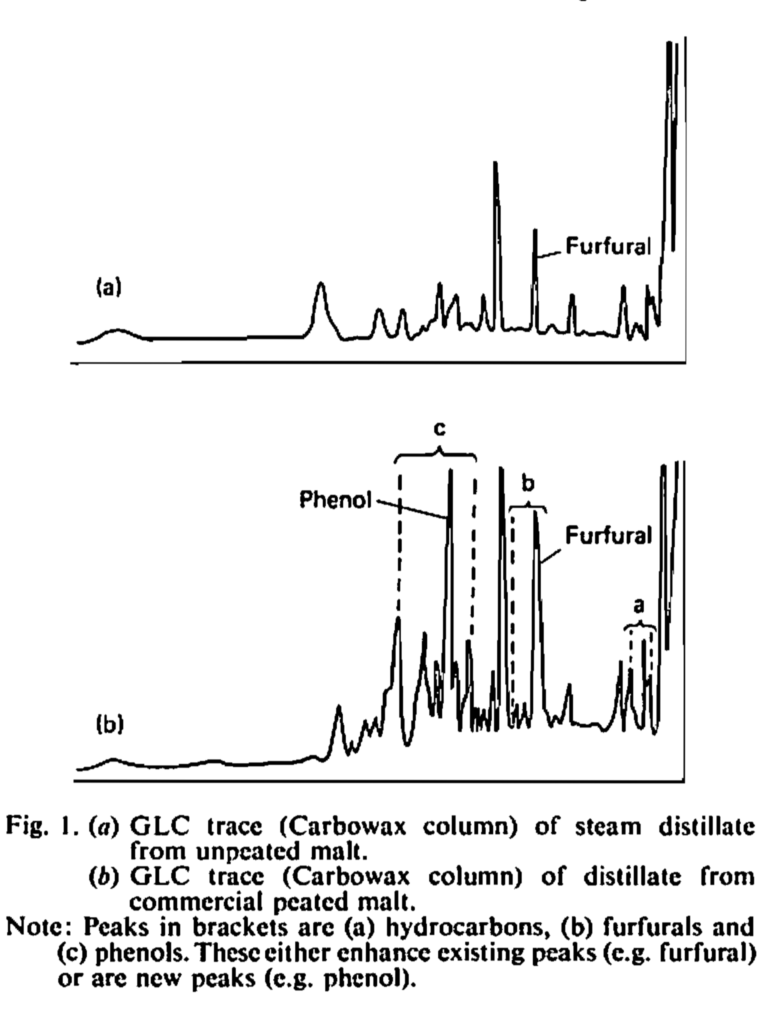
As we can see, a group of phenolic compounds is clearly identified. And below we see a chromatogram, where it is possible to look at a layout of specific phenolic compounds:

The number of phenolic compounds is measured in “parts per million” or ppm, which we love so much. If to make it simple, it is one ten-thousandth part of a percent, i.e. 55 ppm equals to 0,0055%. What is ppm figure for the peatiest whisky for today, Octomore 8.3? 309 ppm, which means there is 0,03% of phenolic compounds in the liquid.
It is quite difficult to control peatiness level while malt drying (different moisture of malt, different peat burning temperature, etc.), so, malting companies simply mix peated and unpeated malt to make a mix with a required level of ppm to meet customers’ specification.
How does it smell like and how do we perceive it?
And now let’s finally see how it smells like:

Not bad, isn’t it?
So, now we understand what phenolic compounds are, how they get into whisky, how they smell and how they are measured, and also why they are mostly measured in malt, not in distillate or in matured whisky. But we have only slightly touched the topic of perception thresholds of phenolic aromas, and here we have very interesting things.
Look at the distribution of various phenolic compounds in the well-known islands’ malts:
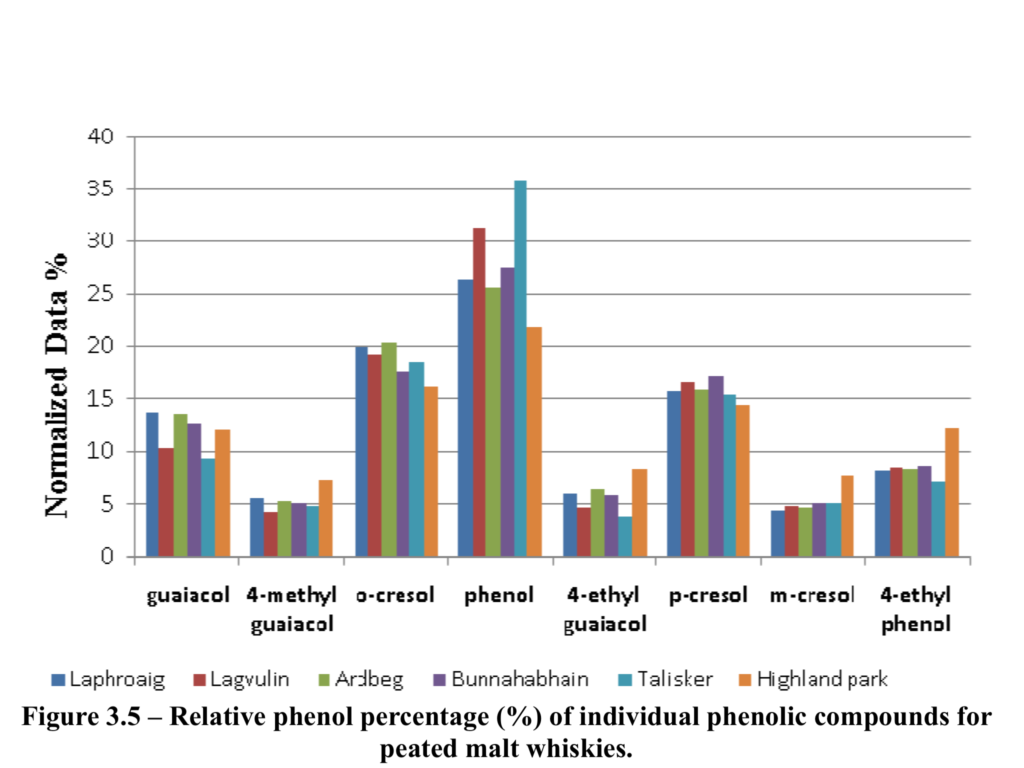
Here is the quantitative expression for these compounds:
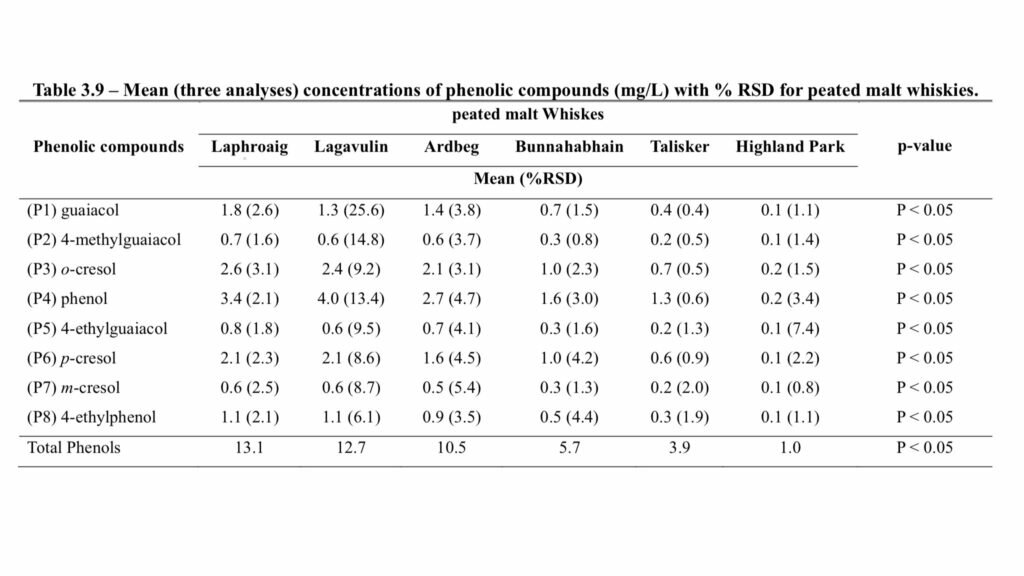
And here is phenolic aroma contribution of that compounds in the products:

So, we see that we have phenol itself, for example, quantitatively twice as much as guaiacol, but guaiacol is far more perceptible in the aroma. This happens due to the fact that guaiacol perception threshold is 4-5 times lower than that one of phenol, we are much more sensitive to the aroma of guaiacol. Thus, different amounts are necessary for different phenolic compounds in order to be spotted by a human nose. Combustion of different types of peat at different temperatures during the malt drying process, together with various modes of distillation on various pot stills, give us an unimaginable quantity of combinations of a peated whisky with accents on a different peat-related aromatic spectrum – medicine, tar, bonfire, ash, etc. And all that we can have at the same phenolic ppm level in the malt.
Besides, different people have different sensitivity to aromas of phenolic compounds. I ran across the information that about 2% of people in the Britain have «phenolic anosmia» – they can not determine a presence of smoke in a low-peated whisky. By the way, what whisky could be called low-peated? Usually, it is a whisky which was produced from the malt with peatiness level less than 5 ppm. In general, if to take into consideration the appearance of new ultra-peated whisky, it is possible to offer the following gradation:

There is one more interesting thing – it seems that a sort of “Marginal Peatiness Paradox” exists. It was repeatedly confirmed by various tasters that ultra-peated whiskies such as Ardbeg Supernova (100 ppm) or Octomore 10YO (167 ppm) may be perceived as less smoky than they should be, i.e. even less smokey than those with peatiness level in malt of 55 or even 40 ppm. It says us that probably human organoleptic apparatus may have a kind of a limit for the perception of a smokey spectrum, and with the excess of some threshold of phenolic compounds content, we stop to feel an increase of peatiness, while a taster may begin to feel other taste components even better. Isn’t it where hides a secret of success of such ultra-peated releases? On the other hand, during writing this article I intentionally conducted a blind tasting of such releases as Octomore 8.3 (309 ppm/5 years), Octomore 8.1 (167 ppm/8 years), Port Charlotte 10 YO (40 ppm/10 years), Port Charlotte Scottish Barley Heavily peated (40 ppm/7 years for the youngest spirit) and Mackmyra Svensk Rök (22 ppm/4 years for the youngest spirit). I recognized unmistakably the first two most peated whiskies in the corresponding sequence both by aroma and by taste. Nevertheless, I remember one case when I was exposed to the Marginal Peatiness Paradox too.
Some figures, finally
Did you notice that we have smoothly switched to a conversation and discussion with references to measurements in ppm? But how it could be if ppm do not tell us about anything?
Let’s go back to measurements. So, we have a malt with a certain amount of phenols. During the production process, we lose a part of the phenolic compounds – quite a bit during the fermentation stage and much more during distillation. Distillation decrease phenolics content, firstly, depending on the shape of pot stills – not all compounds can make their way to a distillate through high pot stills with a significant reflux – and, secondly, depending on the time of tails cut – phenolic compounds have a boiling temperature above the ethanol, i.e. comes in distillation closer to tails. Thus, if distillery tries to get lighter spirits and cuts tails early, then a significant part of phenolic compounds does not get in a new make.
The question is what these volumes are and what is the spread? Let’s look at the data available on the Internet:
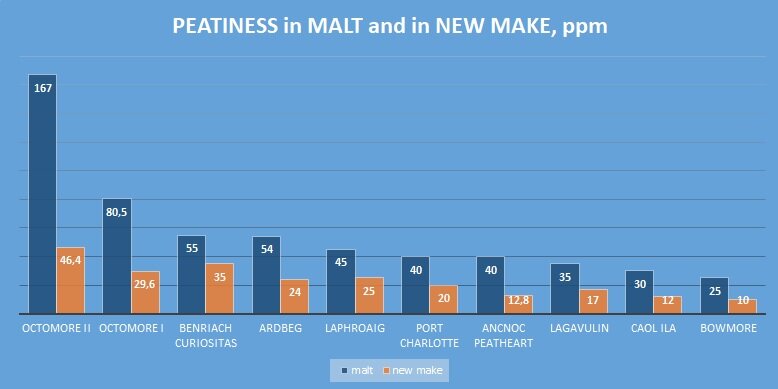
We see that phenolic compounds quantity in a distillate is 2-3 times less than in malt on average. This is the figure we may keep in mind.
Now let’s see what happens during maturation, what are approximate losses in peatiness. Unfortunately, I could not find yet any more or less adequate scientific data for understanding that. Moreover, the data available is highly controversial. There is also no information about the methodology of measurements in matured whisky – so that we could be sure that no phenolic compounds extracted from wood during maturation are measured (tannins, ellagotanins, etc.)
Let’s look at some of the available data, data for Laphroaig (from Peat Smoke and Spirit by Andrew Jefford):
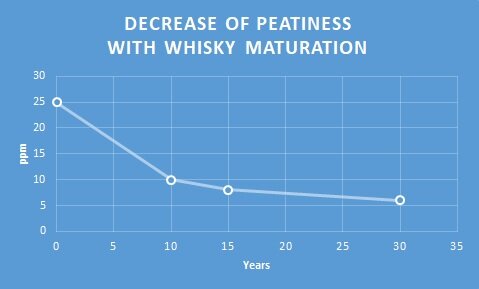
Here is another data, this study was conducted by Balvenie while working on its smoky release Peat Week (information sourced from Dmitry Cherkashin, brand-ambassador of Balvenie, a tasting session on November 2, 2017):

We see here fundamentally different and contradictory data for the same Laphroaig. Meanwhile, Lagavulin has even bigger phenolics level after ageing if to compare with the newmake analysis data! (tannins are also measured?)
How shall we understand and use ppm figures?
So, is this a problem for us in developing measurement criteria for the peated whisky? I don’t think so. In fact, we do not need to understand ppm figures in the absolute, to the comma, we need just to have an ability to compare one whisky with another whisky, an ability to have some anticipation and expectation. That is why I think it is quite enough to have an understanding of ppm level in the malt in order to create maybe not ideal and not very accurate, but a certain system of coordinates. The main point is that everybody shall use the same system of coordinates, otherwise there will be a lot of confusion. For example, once AnCnoc began to print on bottles the data of peatiness in the final product – matured whisky: Rutter 11 ppm, Flaughter 14.8 ppm, Tushkar 15 ppm, Cutter 20.5 ppm. When I tried the last one, I did not know that it was 20 ppm in whisky, not in malt – the gap between the expectations and the reality was so huge that I immediately checked the way the peatiness was measured: it was obvious that it was not 20 ppm in malt, it was much more, it was comparable to Ardbeg releases. So, this system of coordinates works!
As we have already understood, if to use a measurement of peatiness in malt, it is necessary to remember about a considerable variability in the production process. Probably, theoretically, we may reduce that dispersion by making extra studies, by comparing distilleries’ technological processes for prediction of peatiness level in a distillate and in an aged product. Everything is knowable, we may go on with analysis on pot stills shape, or with analysis of smoke of peat from different deposits on a gas chromatograph. The other question is, do we really need it? Is it necessary to check harmony with an algebra? Even with the data available now, if we know not only a figure of ppm in the malt, but if we understanding all the background of this matter, if we know something about a distillery, about maturation, basically, we can understand more or less what peatiness awaits us in whisky — by intensity, and, perhaps, by a character. And then we may compare our expectations and reality. And this is the most interesting thing! We do the same things with ex-bourbon whisky, with sherry-matured spirit, with finishes, etc. The distillery, age, barrels, etc. – we either know something about that and expect something or we try to guess blindly. So, why not to do the same thing with peatiness, using as a guideline phenolic ppm in the malt, though this figure does not fully reflect the real figure of peatiness in the liquid?
So, keep asking brand-ambassadors and tasting session hosts about ppm levels, gentlemen, keep asking, do not hesitate! And shake your heads!
Thanks for reading it up to the very end,
Alexey Nearonov
References and materials for a further reading:
(1), (3) Craig Alexander Wilson, The Role of Water Composition on Malt Spirit Quality, International Center for Brewing and Distilling, School of Life Sciences, Heriot-Watt University, Edinburgh, September 2008;
(2) Barry Harrison (1,2), Joanne Ellis(3), David Broadhurst(3), Ken Reid(2), Royston Goodacre(3), Fergus G. Priest(1), Differentiation of Peats Used in Preparation of Malt for Scotch Whisky Production Using Fourier Transform Infrared Spectroscopy, (1)International Centre for Brewing and Distilling, Heriot-Watt University, Edinburgh; (2)Scotch Whisky Research Institute, Riccarton, Edinburgh; (3)School of Chemistry and Manchester Interdisciplinary Biocentre, University of Manchester, Manchester; The Institute of Brewing & Distilling, 2006;
(4) G. N. Bathgate and A. G. Taylor (Moray Firth Ltd, Inverness), The Qualitative and Quantitative Measurement of Peat Smoke on Distiller’s Malt, November 1976; The Institute for Brewing & Distilling, Vol.83, May-June 1977;
(5), (6), (7), (8) Tao Yang, The Impact of Whisky Blend Matrices on The Sensory Perception of Peaty Flavours, International Center for Brewing and Distilling, School of Life Sciences, Heriot-Watt University, Edinburgh, September 2014;
J. R. Mosedale, Effects of Oak Wood on the Maturation of Alcoholic Beverages with Particular Reference to Whisky, Oxford Forestry Institute, 1995;
Bo Zhang, Jian Cai, Chang-Qing Duan, Malcolm J. Reeves, Fei He, A Review of Polyphenolic in Oak Woods, International Journal of Molecular Sciences, 2015;
Broom D., Phenol Fables: Peat’s Secrets Uncovered; 18/05/2016, scotchwhisky.com
Whisky Science, Peat, whiskyscience.blogspot.com 13/02/2011

